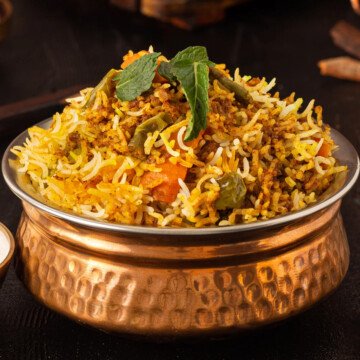
Vegetable Biryani
Vegetable Biryani is a flavorful one-pot dish made with basmati rice, mixed vegetables, and aromatic spices. Cooked together and often garnished with fried onions and fresh herbs, it's a colorful and satisfying meal, typically served with raita or salad.
Ingredients
For Rice:
- 1 ½ Cup Long-grain basmati rice
- 4 Cup Water
- 1 Bay leaf
- 2-3 Green cardamom pods
- 1 Inch cinnamon stick
- 2-3 Cloves
- Salt to taste
For Vegetables:
- 1 Medium potato, diced
- 1 Carrot, diced
- ½ Cup Green peas
- ½ Cup Cauliflower florets
- 1 Medium onion, thinly sliced
- 1 Medium tomato, chopped
- 1 Green chili, slit
- 1 Cup Thick yogurt (curd)
- 2 tablespoon Oil or ghee
- 2 teaspoon Ginger-garlic paste
For Biryani Masala:
- 1 teaspoon Cumin seeds
- 1 teaspoon Coriander powder
- ½ teaspoon Turmeric powder
- 1 teaspoon Garam masala
- 1 teaspoon Biryani masala (optional)
- ½ teaspoon Red chili powder
- 1 teaspoon Cumin powder
- 1 teaspoon Black pepper powder
For Layering:
- 2 tablespoon Fresh coriander leaves, chopped
- 2 tablespoon Fresh mint leaves, chopped
- 1 tablespoon Saffron strands soaked in ¼cup warm milk
- 1 tablespoon Fried onions (optional)
Optional Garnishes:
- Cashews or almonds, fried in ghee
- Raisins, fried in ghee
Instructions
Preparing the Biryani Base:
- Firstly, heat oil or ghee in a large pan and add whole spices like cinnamon sticks, cardamom, cloves, and bay leaves.
- After that, add finely chopped onions, garlic, and ginger to the pan. Sauté them until the onions turn golden and soft. This step is crucial as it brings out the depth of flavor in the biryani.
Marinating the Vegetables:
- Secondly, in a separate bowl, mix your choice of vegetables (carrots, peas, potatoes, beans, etc.) with yogurt, turmeric, chili powder, and garam masala.
- You can let the vegetables marinate for at least 30 minutes to allow them to soak in the spices properly.
Layering the Biryani:
- Next, cook the rice separately, but make sure it’s slightly undercooked (about 70% cooked). This will help it absorb the flavors when it's layered with the vegetables and spices.
- Then, in a large pot, start the layering process: first, add a layer of rice at the bottom, followed by a layer of the marinated vegetables. Correspondingly, repeat this layering until all the rice and vegetables are used up.
- Furthermore, sprinkle some fried onions, mint, and coriander leaves on each layer to enhance the fragrance and texture of the biryani.
The Dum Cooking Method:
- Afterwards, it's time for the dum cooking method! This involves sealing the pot tightly with a lid or dough so that no steam escapes.
- Simultaneously, place the pot on a low flame and let it cook for 20-30 minutes. This slow cooking process ensures the rice becomes fluffy while absorbing all the delicious spices. As a result, you get perfectly cooked, flavorful biryani!
- Finally, after the biryani is done, let it rest for a few minutes before opening the lid. This helps the flavors settle and makes it easier to serve.
Serve
- Finally, once the biryani is done, gently fluff it with a fork. Garnish with fried cashews, raisins, and fresh coriander leaves. Serve hot with raita, papad, or salad!
Notes
Serving Suggestions & Pairing Ideas
-
- Naan or Paratha: Want a more indulgent meal? Serve the biryani with warm, buttery naan or flaky parathas. These sides make the meal even more delicious!
-
- Raita Pairing: To cool down the spices, serve your biryani with some raita—like cucumber raita or onion-tomato raita. It balances the heat and adds a refreshing touch!
-
- Salads: Add a fresh side salad like kachumber or a simple onion-tomato-cucumber mix. These salads are light and give a nice contrast to the rich biryani!
-
- Pickles & Papad: For extra tang and crunch, pair your biryani with mango pickle, lime pickle, or crispy papad. It’s the perfect burst of flavor!
Tips for Making the Best Vegetable Biryani
1. Rice to Water Ratio: First of all, getting the right rice-to-water ratio is key. For perfect rice texture, use a 1:1.5 or 1:2 ratio (rice to water). This helps avoid mushy rice and ensures each grain stays fluffy and separate. 2. Fried Onions: Don’t forget to add crispy fried onions as a garnish. Not only do they add a nice crunch, but they also bring a hint of sweetness, which enhances the texture and flavor of the biryani. 3. Saffron Infusion: Furthermore, for a rich color and amazing aroma, infuse saffron threads in warm water or milk. Then, drizzle this golden liquid over the biryani before cooking—it’s the secret to a beautiful, fragrant dish! 4. Dum Sealing Tips: Lastly, to ensure the biryani cooks perfectly on "dum" (slow cooking), seal the pot with dough or foil. This traps the steam, locking in all the delicious flavors and making your biryani even tastier!Nutrition
Nutrition Facts
Vegetable Biryani
Amount per Serving
Calories
1855
% Daily Value*
Fat
43
g
66
%
Saturated Fat
9
g
56
%
Polyunsaturated Fat
4
g
Monounsaturated Fat
10
g
Sodium
20
mg
1
%
Potassium
2390
mg
68
%
Carbohydrates
289
g
96
%
Fiber
25
g
104
%
Sugar
10
g
11
%
Protein
36
g
72
%
Vitamin A
509
IU
10
%
Vitamin B1
0.3
mg
20
%
Vitamin B2
0.2
mg
12
%
Vitamin B3
2
mg
10
%
Vitamin B5
0.6
mg
6
%
Vitamin B6
0.4
mg
20
%
Vitamin C
103
mg
125
%
Vitamin E
1
mg
7
%
Vitamin K
310
µg
295
%
Calcium
600
mg
60
%
Iron
8
mg
44
%
* Percent Daily Values are based on a 2000 calorie diet.
Tried this recipe?Let us know how it was!